The reporting for this article was made possible with a grant from NACLA’s Samuel Chavkin Investigative Journalism Fund.
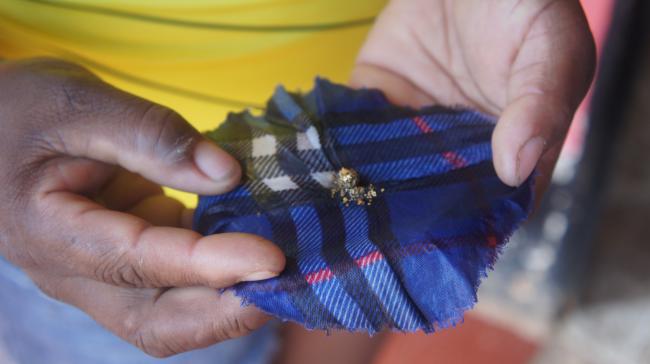 Nineteen-year-old Jorge Velasco felt a terrifying sense of vertigo as muddy water from the Cauca River filled the mine shaft where he was working the morning of May 13, 2015. He managed to scramble out, his boots becoming leaden, feeling anguished as he left his close friend Victor Alfonso Flores Soto behind. Flores and 14 other miners perished in the informal mine known as “Don Leo,” trapped in tunnels between 45 and 90 feet deep. It took rescuers almost two weeks to drain the mine and remove all the bodies. At that point the corpses were bloated and decomposed beyond recognition. The rescuers were themselves miners from small, informal mines in the surrounding area.
Nineteen-year-old Jorge Velasco felt a terrifying sense of vertigo as muddy water from the Cauca River filled the mine shaft where he was working the morning of May 13, 2015. He managed to scramble out, his boots becoming leaden, feeling anguished as he left his close friend Victor Alfonso Flores Soto behind. Flores and 14 other miners perished in the informal mine known as “Don Leo,” trapped in tunnels between 45 and 90 feet deep. It took rescuers almost two weeks to drain the mine and remove all the bodies. At that point the corpses were bloated and decomposed beyond recognition. The rescuers were themselves miners from small, informal mines in the surrounding area.
Colombia is rich in gold. The great majority of it is extracted through informal operations, many considered illegal, that proliferate across the country— from the Pacific lowlands to the Amazon to the coffee-growing region in the state of Caldas, where the Don Leo mine was located. Tragedies like the one at Don Leo are among the reasons the government has launched a “formalization” process to improve conditions and standardize practices at informal mines. Environmental contamination from informal mining —which often involves the use of mercury, cyanide, and other chemicals— is another reason. In addition to these concerns is the fact that illegal gold mining has become a major source of financing for armed paramilitary, guerrilla, and criminal groups.
In 2013, the government of President Juan Manuel Santos launched a formalization process intended to provide training and improve conditions and worker benefits for informal miners. The plan looks promising on paper. However, it raises a host of thorny questions. Who should be allowed to mine where, given conflicting ancestral and legal claims to land and the minerals therein? How will the plan deal with mining operations controlled by or profiting armed groups, considering that these mines also often employ local people? And can the government truly muster the resources or political will to improve environmental practices and safety in informal mines, like Don Leo, which was in the process of formalization when the disaster occurred?
A Patchwork of Methods
Gold extraction in Colombia is often broken down into three or four tiers, and the lines between them are often blurry. About 314,000 people work in small and medium-scale mining, according to the country’s 2011-2012 mining census. Many people practice artisanal or ancestral mining, which in its most rudimentary form involves panning in rivers, using wide wooden pans to separate golden grains from sand. Small miners also tunnel with picks and other hand tools to extract gold-laced earth and ore.
Medium-scale mining involves more machinery and impacts larger areas. Homemade explosives are used to blast shafts underground, often in dangerous conditions like at Don Leo. In other environmentally destructive situations, like at the Los Farallones de Cali National Park, mercury, cyanide, and blasting from illegal mining have contaminated rivers that provide water for the city of Cali.
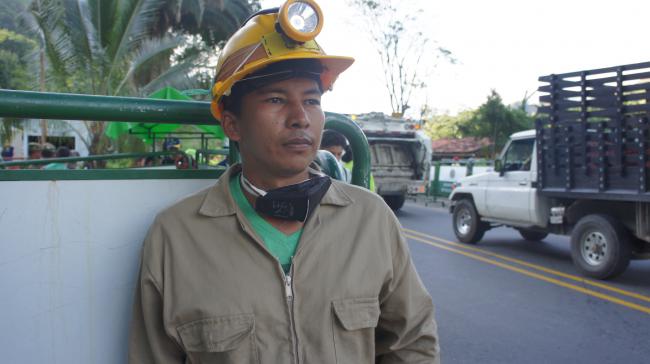
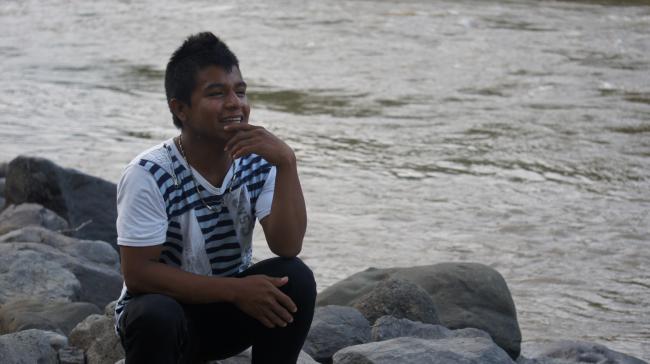
On rivers, including in the Pacific Chocó department and in the Amazon, “mining” also involves aquatic dredging operations. Dragas is the term often used for small inflatable floats outfitted with motorized pumps and hoses that suck up the river bottom and run it through sifting mechanisms. Much larger operations, often called dragones, are hulking contraptions standing 20 feet high or more with workers stationed on several levels, overseeing a cacophonous cascade of silt, water, and rocks tumbling down sluices.
The people and groups carrying out these types of mining operations vary widely. There are ad hoc companies or cooperatives like Don Leo, as well as individuals, families or other groups working together. The law grants indigenous people and Afro-Colombians the right to mine, as many have for centuries. Afro-Colombians are largely descended from slaves brought to the country for gold mining, and small-scale mining has been part of their culture ever since. Now small-scale, artisanal mining is being threatened by the entry of more advanced, medium-scale illegal mining, often carried out by outsiders coming to Afro-Colombian or indigenous territories. While panning for gold could be considered truly sustainable, leaving virtually no impact on the environment, the medium-scale, informal operations can be highly destructive, tearing up land and river bottoms and often releasing mercury, cyanide, or other chemicals into the environment.
According to experts, government officials and locals, paramilitary and guerrilla forces have become increasingly involved in illegal or informal mining in recent years. They run mining operations themselves, or charge locals a “protection fee” to allow them to keep mining or to bring machinery into areas the armed groups control. For example the Revolutionary Armed Forces of Colombia (FARC) guerrilla group reportedly charged $1,600 or more for each piece of equipment; they also charged for gasoline or demanded a cut of mining profits, according to 2012 studies.
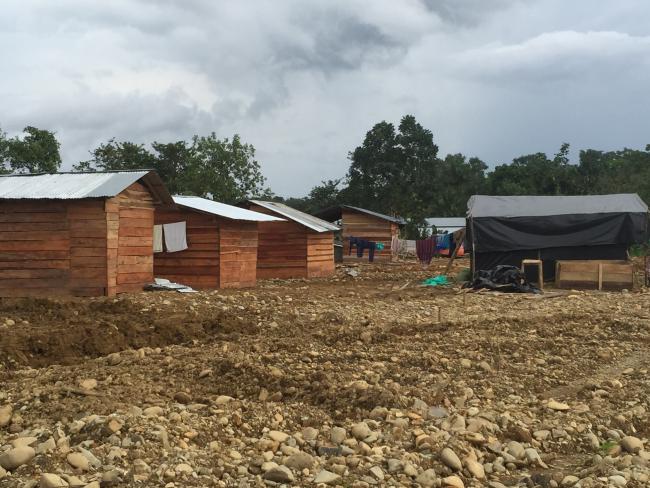
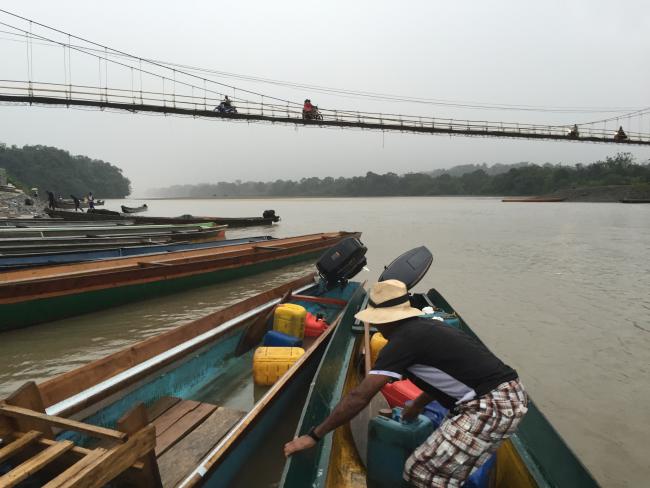
As a backdrop to this complicated patchwork loom multinational companies, which hold the official titles to substantial portions of Colombia’s mineral riches. In some places, like the town of Jericó in Antioquia or San Lorenzo in Nariño, multinational companies and their subsidiaries are running large mines. Although mining by major companies makes up only a tiny fraction of the country’s gold mining— just one percent, according to the 2011-2012 mining census— many communities see their presence and presumed power to displace smaller miners and whole towns as a serious threat. In many areas, companies are exploring or otherwise maintaining a presence, presumably setting the stage to launch operations if gold prices rise or deposits and conditions prove worth their while. For example, officials from the South African company AngloGold Ashanti have, according to locals, been conducting exploration in and around the indigenous reserve that includes the Don Leo mine since 2008. Residents say that people connected to the company have been doing helicopter flyovers and approaching locals about buying land. A spokesman for AngloGold Ashanti reviewing questions for this story did not respond to questions about such reports by the time of publication.
Formalization, Criminalization, and Chaos
The question of what separates an “informal” mine from an “illegal” one is hard to answer, and the answer varies for any given mine depending on whom you ask and when. Since at least the 1980s, Colombia has instituted a series of laws and programs aimed at defining, handling, and formalizing small-scale and informal mining.
In 2001, a new mining code was instituted that laid the groundwork to extensively grant titles to minerals, which, as in the U.S., are separate from land ownership. With the new code in place, then-president Álvaro Uribe Vélez’s administration awarded a slew of mineral rights titles, many of them to foreign corporations or their subsidiaries, ultimately covering more than half of the country’s territory.
The code, intended to foster foreign investment, weakened the ability of indigenous and Afro-Colombian groups to veto mining on their land. It was later revealed that the Uribe administration awarded 9,000 mining titles in national parks and indigenous reserves. In 2011, according to Semana newspaper, the former Mining and Energy minister, Carlos Rodado, decried mining titles that had been granted in national parks and other developments since the implementation of the 2001 code, including "awarding of titles without control and under some manner of suspicion” and the “violation of the rights of indigenous mining communities and Afro-Colombians.”
Complicating matters, it is not always the new titleholders who wind up doing the actual exploration or mining. Instead, other entities are extracting gold rather than the actual mineral rights holders. In fact, the country’s 2011-2012 mining census included more than 14,000 mining operations, and found 63 percent of them with no legal title.
Despite this disconnect, in 2013, the government of President Juan Manuel Santos announced the ambitious formalization program intended to grant legal rights and provide training to informal operations, while also cracking down on mining the government considers illegal. "We have to be even more effective at recovering the artisanal miners to become formal," Santos said at an August meeting of the National Agency of Mines, according to a press release from the agency. Santos added that safety requirements instituted through formalization have “saved a number of lives.”
The press release also quoted Minister of Mines and Energy Tomás González, who said that “mining without a title will bring the full weight of the law.” He added that miners who “do things right… have to feel that the Government is your friend.”
But critics say the government has failed to distinguish between “small” and “illegal” miners or effectively grant rights to small miners. Oswaldo Ordoñez, a geology professor at the National University of Colombia in Medellín who has advised the formalization process, said that small miners, who have often been mining the land for decades, often don’t have rights.“They’ve been working 20 to 30 years in these mines, and their parents mined, but they don’t have the [mineral] rights - the government gave the rights to speculators…So now you have conflict between people with titles who never did anything and people mining the land who don’t have the rights.”
Many small, independent miners including indigenous and Afro-Colombians lack the resources to apply for legal titles, a process that requires paperwork, studies, and trips to cities. Citing a backlog and other problems, the government has opened and closed windows in which miners can apply for titles, causing much uncertainty and confusion. Meanwhile, rights are granted to people who have never even touched the land.
Despite the government’s aims to formalize all mines by 2032, so far the program has been marked by glacially slow progress, chaos, and inconsistencies. Only a tiny fraction of mines have been formalized. A 2014 report by the London-based International Institute for Environment and Development notes that between the passage of the 2001 code and November 2013, 80 percent of 3,114 applications to formalize mines were rejected. Only five percent of those successful applications have been registered. Today, some 19,500 applications by artisanal and small-scale miners from previous formalization processes are still awaiting replies from the National Mining Agency. The program has cost about $25 million.
In 2012, a law imposed serious criminal charges for mining illegally, without differentiating between independent small miners and larger operations. The government has made numerous arrests of miners, including a May 2015 crackdown in the Amazon, where the government arrested 59 people and shut down 63 illegal mines alleged to be funding the FARC. After protests, the law was clarified to target medium-sized and large illegal operations, rather than small miners.
Meanwhile, many artisanal miners and communities say the government is largely turning a blind eye to environmentally destructive illegal mining operations controlled by armed groups that perpetrate threats and violence.
Cauca: A Climate of Fear
A cool breeze stirred the geraniums and herbs hanging in pots ingeniously made from plastic water bottles, suspended from the eaves of a bright pink house on a verdant hillside above the town of Suarez in the Cauca department on the afternoon of May 22, 2015.The women of the community of La Toma demonstrated how they swirl river water in wooden pans to separate out tiny flecks of gold. One woman displayed a small cluster of these grains, cradled carefully in a piece of blue plaid fabric. It weighed about two grams and might fetch about 95,000 pesos, they said, less than $50USD.

A phone call brought news that the FARC had just lifted its ceasefire, in response to the government killing of 26 FARC fighters a day earlier. The government described that attack as a response to the April killing of 11 soldiers nearby in Buenos Aires, despite the unilateral ceasefire that was in effect as peace talks were ongoing in Havana.
Colombia’s civil war has gone on for decades, but in the past decade the advent of illegal gold mining as a source of funding for armed groups has meant extreme pressure and risk for La Toma and other Afro-Colombian communities scattered throughout these hills and valleys.
Men, women, and children from La Toma and other communities have long panned for gold along the Ovejas River, which just downstream of the community meets the Cauca River, the same one that flooded the Don Leo mine.
Today medium-scale open-air mining operations dot the landscape. From the pink house where the women gathered, the paths of backhoes are easily visible, jagged lines of exposed red earth cutting through green forest.
An international advocate who works closely with La Toma, and asked his name not be used for security reasons, said at that time there were 17 backhoes used for illegal mining in the surrounding area. The women say illegal mining connected with armed groups has nearly destroyed their ability to survive in the way their people have for centuries: through small-scale agriculture and panning for gold. They say illegal mining is polluting the rivers with mercury and other chemicals. The amount of gold they find panning is significantly reduced, and threats from armed groups mean they cannot go to many of the riverine sites and small farm plots where they have long worked.
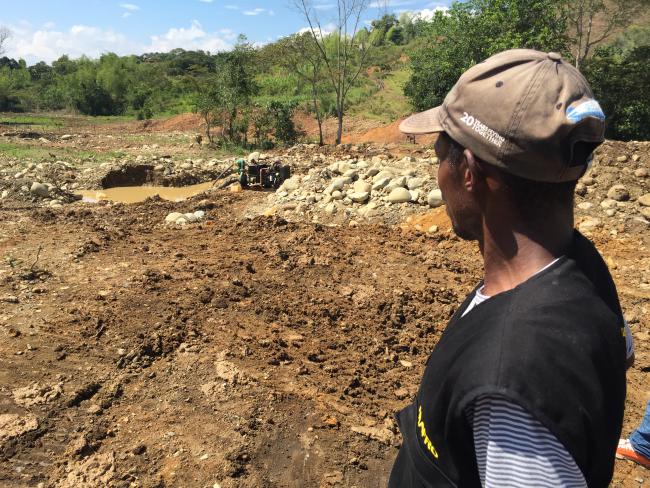
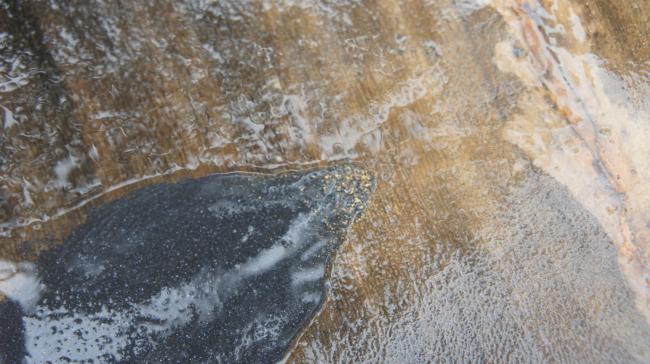
Under the Colombian Constitution and consulta previa laws, indigenous and Afro-Colombian people have the right to “free, prior and informed consent” regarding mining or other activities that affect their land. La Toma leader Francia Márquez invoked this right in a lawsuit that suspended mining titles that could have forced the Afro-Colombian community to relocate.
A 2010 decision in Márquez’s favor by the Colombian Constitutional Court meant mining could not legally begin without the community’s consent. The agreements also called for the government to award the community collective land titles, which are promised to Afro-Colombian communities by law. Leaders say this would help them protect their land against mining by outsiders. But although the community has made multiple demands that the government stop illegal mining, and despite the fact that the government officials have agreed to do so in signed documents, it hasn’t happened.
Extensive mineral titles in the area had been awarded to one individual, Hector Jesus Sarria. Community leaders believed he was stockpiling the titles on behalf of companies. AngloGold Ashanti and the Canadian company Cosigo Resources are among the multinationals that were also awarded titles and sought to mine in the area. (AngloAshanti Gold had not responded to requests for comment by press time.)
The most recent agreement between the government and La Toma came after more than 50 women from the community, together with many supporters, marched to Bogotá in November 2014. The group spent 22 days occupying the Ministry of the Interior, and the protest drew international attention and solidarity. But since returning from the march, the women said, they’ve faced increased death threats and intimidation from people affiliated with illegal mining and armed groups.
One woman reported that a few weeks after the march, a man visited her home and told her she would end up “with flies in her mouth.” In late December 2014, the women said, a backhoe was burned, presumably by government forces— a common way that the government tries to curb illegal mining. But armed actors blamed the community for the destruction and made specific threats in retaliation, the women contended.
While there is a heavy guerrilla presence in the area, threats related to illegal mining have also come from violent groups with paramilitary connections, including the Aguilas Negras (Black Eagles) and the Rastrojos. Advocates have circulated images of a threatening, typewritten note, found in February 2015. Below a logo for the Rastrojos, it names Márquez and other protest leaders. The note demands, “No more persecution of mining, no more marches,” adding that “mining is part of development.”
The next installment explores the impact of gold mining Chocó, Marmato and Járdin.
Kari Lydersen is a Chicago-based journalist, author and journalism professor. She co-directs the Social Justice News Nexus, a fellowship program at Northwestern University, and teaches journalism at Northwestern. She is the author of five books, including Mayor 1%: Rahm Emanuel and the Rise of Chicago's 99%. Her work has appeared in outlets including the New York Times, Washington Post, The Economist and People Magazine.
Adriana Cardona-Maguigad is a Colombian journalist based in Chicago. Adriana is the co-founder and former editor of The Gate newspaper, a hyper-local and bilingual community news publication on the southwest side of Chicago. She was part of the inaugural class of the Social Justice News Nexus fellowship program where she currently works. Her work has been featured in outlets including WBEZ, NPR's This American Life and Hoy Newspaper.

